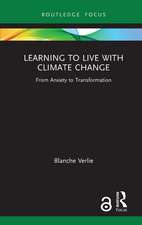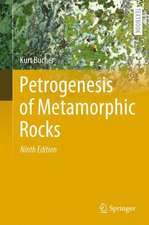Geothermal Energy: From Theoretical Models to Exploration and Development
Autor Ingrid Stober, Kurt Bucheren Limba Engleză Hardback – 18 dec 2013
| Toate formatele și edițiile | Preț | Express |
|---|---|---|
| Paperback (2) | 702.05 lei 6-8 săpt. | |
| Springer International Publishing – 26 mai 2022 | 702.05 lei 6-8 săpt. | |
| Springer Berlin, Heidelberg – 27 aug 2016 | 727.00 lei 6-8 săpt. | |
| Hardback (2) | 807.80 lei 39-44 zile | |
| Springer Berlin, Heidelberg – 18 dec 2013 | 807.80 lei 39-44 zile | |
| Springer International Publishing – 25 mai 2021 | 1011.03 lei 6-8 săpt. |
Preț: 807.80 lei
Preț vechi: 1062.89 lei
-24% Nou
Puncte Express: 1212
Preț estimativ în valută:
154.58€ • 165.29$ • 128.88£
154.58€ • 165.29$ • 128.88£
Carte tipărită la comandă
Livrare economică 14-19 aprilie
Preluare comenzi: 021 569.72.76
Specificații
ISBN-13: 9783642133510
ISBN-10: 3642133517
Pagini: 350
Ilustrații: 20 schwarz-weiße Tabellen
Dimensiuni: 155 x 235 x 22 mm
Greutate: 0.57 kg
Ediția:2013
Editura: Springer Berlin, Heidelberg
Colecția Springer
Locul publicării:Berlin, Heidelberg, Germany
ISBN-10: 3642133517
Pagini: 350
Ilustrații: 20 schwarz-weiße Tabellen
Dimensiuni: 155 x 235 x 22 mm
Greutate: 0.57 kg
Ediția:2013
Editura: Springer Berlin, Heidelberg
Colecția Springer
Locul publicării:Berlin, Heidelberg, Germany
Public țintă
Professional/practitionerCuprins
1.
Thermal
Structure
of
the
Earth.-1.1
Renewable
Energies,
Global
Aspects.-1.2Internal
Structure
of
the
Earth.-1.3Energy
budget
of
the
planet.-1.4Heat
transport
and
thermal
parameters.-1.5Brief
outline
of
methods
for
measuring
thermal
parameters.- 2.
History
of
Geothermal
Energy
Use.-2.1
Early
utilization
of
geothermal
energy.-2.2
History
of
Utilization
of
Geothermal
Energy
in
the
last150
Years.- 3.
Geothermal
Energy
Resources.-3.1
Energy.-3.2
Significance
of
"renewable"
energies.-3.3
Status
of
geothermal
energy
utilization.-3.4
Geothermal
energy
sources.- 4.
Application
of
Geothermal
Energy.-4.1
Near
surface
Geothermal
Systems.-4.2
Deep
Geothermal
Systems.-4.3
Efficiency
of
geothermal
systems.-4.4
Major
geothermal
fields,
high
enthalpy
fields.- 5.
Potentials
and
Perspectives
of
Geothermal
Utilization.- 6.
Geothermal
Probes.-6.1
Planning
Principles
.-6.2
Construction
of
ground
source
heat
exchangers.-6.3Dimensioning
and
design
of
geothermal
probes.- 6.4Drilling
methods
for
borehole
heat
exchanger.-6.5
Backfill
and
grouting
of
geothermal
probes.-6.6
Construction
of
deep
geothermal
probes.-6.7
Operating
geothermal
probes:
Potential
risks,
malfunctions
and
damages.-6.8
Special
systems
and
further
developments.- 7.
Geothermal
Well
Systems.-7.1
Building
geothermal
well
systems.-7.2
Chemical
aspects
of
two-well
systems.-7.3
Thermal
range
of
influence,
numerical
models.- 8.
Hydrothermal
Systems,
Geothermal
Doublets.-8.1
Geology
and
tectonic
structure
of
the
underground.-8.2
Thermal
and
hydraulic
properties
of
the
target
aquifer.-8.3Hydraulic
and
thermal
range
of
hydrothermal
doublets.-8.4
Hydrochemistry
of
hot
waters
from
great
depth.- 8.5Reservoir-improving
measures,
Efficiency-boosting
measures,
Stimulation.-8.6
Productivity
risk,
Exploration
risk,
Economic
efficiency.-8.7
Some
site
examples
of
hydrothermal
systems.-8.8Project
planning
of
hydrothermal
power
systems.- 9.
Enhanced-Geothermal-Systems
(EGS),
Hot-Dry-Rock
Systems
(HDR),
Deep-Heat-Mining
(DHM).-9.1Techniques,
procedures,
strategies,
aims.-9.2Historical
development
of
the
hydraulic
fracturing
technology,
early
HDR
sites.- 9.3Stimulation
procedures.-9.4
Experience
and
dealing
with
micro-seismicity.-9.5Recommendations,
Notes.- 10.Environmental
Issues
Related
to
Deep
Geothermal
Systems.-10.1
Seismicity
related
to
EGS
projects.-10.2
Interaction
between
geothermal
system
operation
and
the
subsurface.-10.3Environmental
issues
related
to
surface
installations
and
operation.-11. Drilling
techniques
for
deep
wellbores.- 13. Geophysical
methods,
exploration
and
analysis.-12.1
Geophysical
pre-drilling
exploration,
seismic
investigations.-12.2
Geophysical
well
logging
and
data
interpretation.- 13.Testing
the
hydraulic
properties
of
the
drilled
formations.-13.1
Principles
of
hydraulic
testing.-13.2
Types
of
tests,
planning
and
implementation,
evaluation
procedures.-13.3
Tracer
Experiments.-13.4
Temperature
evaluation
methods.- 14.
The
chemical
composition
of
deep
geothermal
waters
and
its
consequences
for
planning
and
operating
a
geothermal
power
plant.-14.1
Sampling
and
laboratory
analyses.-14.2
Deep
geothermal
waters,
data
and
interpretation.-14.3
Mineral
scales
and
materials
corrosion.- 15.
References
Recenzii
Book:
Petrogenesis
of
metamorphic
rocks
(Bucher
&
Frey)
Springer-Verlag
2002
Customer
reviews
on
Amazon.com
one
of
the
best
textbooks
available,
10.
April
2000
Von
Katharina
Dubach
Petrogenesis
of
metamorphic
rocks
is
probable
the
best
textbook
available
for
students
of
metamorphic
petrology.
In
a
short,
concise
form
it
introduces
the
reader
to
the
principles
of
metamorphic
petrology
as
well
as
to
the
evolution
of
different
rock
types
under
changing
metamorphic
conditions.
Excellent source for anyone studying metamorphic rocks., 2. Juni 1999 Von Ein Kunde This book is divided into two sections. The first section deals with the basic princiles of metamorphism, including composition of source rocks, types, processes and condidtions of metamorphism. A very detailed description on the construction of metamorphic projections is also included. Part two covers the metamorphism of different rock compositions including ultramafic, mafic, carbonate, pelitic, and granitoid rocks. This section is very detailed, without bogging down with specific examples of metamorphism.
Excellent source for anyone studying metamorphic rocks., 2. Juni 1999 Von Ein Kunde This book is divided into two sections. The first section deals with the basic princiles of metamorphism, including composition of source rocks, types, processes and condidtions of metamorphism. A very detailed description on the construction of metamorphic projections is also included. Part two covers the metamorphism of different rock compositions including ultramafic, mafic, carbonate, pelitic, and granitoid rocks. This section is very detailed, without bogging down with specific examples of metamorphism.
Notă biografică
Ingrid
Stober:
Studied
Earth
Sciences
at
the
University
of
Freiburg
(Germany).
1985
Ph.D.
with
the
dissertation
on
“groundwater
flow
patterns
in
hard-rock
aquifers,
results
from
pumping-
and
injection-tests”.
1994
habilitation
thesis
on
"hydrogeology
of
crystalline
rocks
of
the
Black
Forest,
Germany".
She
is
working
at
the
Geological
Survey
of
Baden-Württemberg,
with
the
responsibility
for
geothermal
energy.
Her
research
interests
are
geothermal
waters
and
hydraulics.
Kurt Bucher: Studied Geology at ETH Zurich (Switzerland). 1977 Ph.D. in metamorphic petrology. Assistant professor at the University of Basel (Switzerland), Professor of Geology at the University of Oslo (Norway) and is currently Full Professor of Mineralogy and Geochemistry at the University of Freiburg (Germany). His research is focused on field studies of water-rock interaction processes in deep geothermal systems.
Kurt Bucher: Studied Geology at ETH Zurich (Switzerland). 1977 Ph.D. in metamorphic petrology. Assistant professor at the University of Basel (Switzerland), Professor of Geology at the University of Oslo (Norway) and is currently Full Professor of Mineralogy and Geochemistry at the University of Freiburg (Germany). His research is focused on field studies of water-rock interaction processes in deep geothermal systems.
Caracteristici
Presents
a
combination
of
theory
and
applied
cases
Focuses on the geological context and geophysical and geochemical aspects of geothermal exploration
Unique book for lecturers and students alike
Focuses on the geological context and geophysical and geochemical aspects of geothermal exploration
Unique book for lecturers and students alike
Textul de pe ultima copertă
The internal heat of the planet Earth represents an inexhaustible reservoir of thermal energy known as Geothermal Energy. The 2nd edition of the book covers the geologic and technical aspects of developing all forms of currently available systems using this "renewable" green energy. The book presents the distribution and transport of thermal energy in the Earth. Geothermal Energy is a base load energy available at all times independent of climate and weather. The text treats the efficiency of diverse shallow near surface installations and deep geothermal systems including hydrothermal and petrothermal techniques and power plants in volcanic high-enthalpy fields. The book also discusses environmental aspects of utilizing different forms of geothermal energy, including induced seismicity, noise pollution and gas release to the atmosphere. Chapters on hydraulic well tests, chemistry of deep hot water, scale formation and corrosion, development of geothermal probes, well drillingtechniques and geophysical exploration complete the text. This book, for the first time, covers the full range of utilization of Geothermal Energy.





























